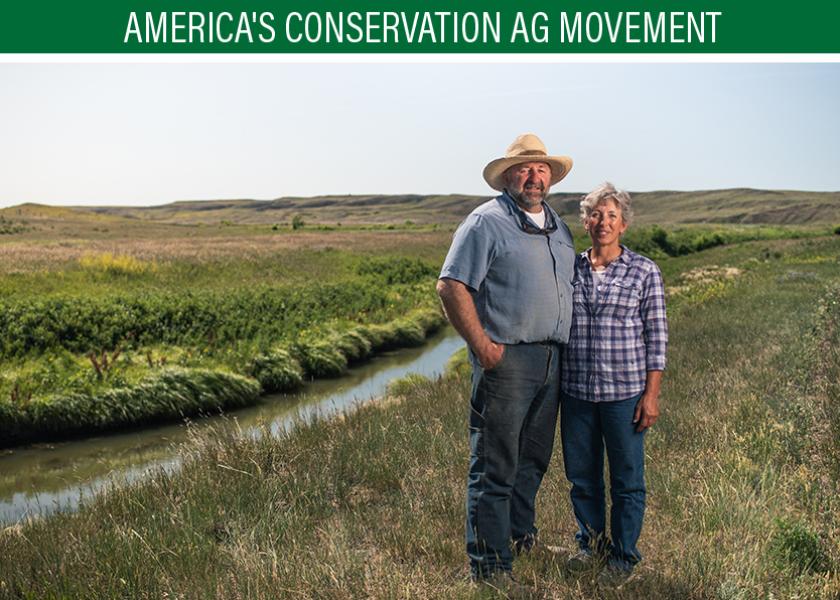Grazing in Harmony

Craig and Conni French always considered themselves good land stewards, but six years ago things really began to change. They came to realize their cattle ranch’s fate was tied to healthy soils and grasses.
“We are a part of this ecosystem,” Conni says. “How do we live in harmony and work together within this system?”
They found the answer in holistic ranch management techniques, which called into question long-held, traditional ways of thinking. Toward that end, the Frenches implemented rotational grazing on their C Lazy J Livestock operation in Phillips County in north central Montana.
The drastic changes that followed required a leap of faith for the fourth-generation ranchers. They traded harvesting hay for grazing methods that let their cattle harvest the forage themselves. Such changes didn’t happen overnight, and each came with its own risk and learning curve.
“To be a steward of the land in my mind is recognizing the importance of a natural resource, and it is to be harvested,” Craig said of the grass on the ranch. “That’s the whole point of renewable.”
The Frenches recognize that without a healthy, sustainable land base they will not be able to carry the ranch into the future. Increasing grass and soil health are considerations that are always front of their minds in their decision-making process.
With the use of electric fence, they have increased the number of cattle moves and the number of pastures. They now move cattle around 40 times per summer. This allows for increased rest for each pasture and more control over where and when cattle are grazing.
Last fall Craig and Conni were the recipients of the Montana Leopold Conservation Award®, given in honor of renowned conservationist Aldo Leopold. The prestigious award recognizes farmers, ranchers and forestland owners who inspire others with their dedication to land, water and wildlife habitat management on private, working land.
“Recipients of this award are real life examples of conservation-minded agriculture,” said Kevin McAleese, Sand County Foundation President and Chief Executive Officer. “These hard-working families are essential to our environment, food system and rural economy.”
“Setting themselves apart, the Frenches are ranching in sync with the soils, vegetation, insects and wildlife they steward alongside their operation and for the benefit of their community, sharing their experiences with others,” said John Piotti, president and CEO of American Farmland Trust.
The use of cell grazing (a form of rotational grazing that moves a large herd frequently to new pastures) allows more recovery time for perennial vegetation to flourish on a semi-arid, brittle environment of short prairie grass. This results in better forage and wildlife habitat.
The Frenches make decisions not just with their cattle herd’s health in mind, but also the impact on soil, insects and wildlife and the ranch’s financial and human health. Targeted grazing of non-native grasses has improved habitat for grassland birds and sage grouse.
With assistance from the NRCS’s Environmental Quality Incentives Program, they moved livestock water tanks and windbreaks away from a creek. Beaver Creek flows through three miles of the ranch and its health is a conservation priority for the French family. The return of willow trees along the creek’s banks is a sign their efforts are paying off.
The Frenches collaborate with federal and state agencies, non-profits and other ranchers to achieve conservation success.
Their voluntary 30-year conservation lease with Montana’s Fish, Wildlife, and Parks ensures their land’s native grassland and sagebrush will remain uncultivated and undeveloped. Likewise, hunters are allowed access to their ranch’s thriving wildlife populations through enrollment in the state’s Block Management program.
The Frenches have also agreed to sustain and improve habitat for four species of imperiled grassland birds and sage-grouse, and have their numbers surveyed.
As long-time members of The Ranchers Stewardship Alliance, a rancher-led conservation group that aims to educate within and outside the ranch community, the Frenches share their experience with holistic management, cell grazing and other innovative conservation practices.
The Frenches, who farm with their three children, aren’t ones to rest on their laurels. They plan to treat 320 acres of recently purchased farmland as a demonstration site for the soil health benefits of cover crops. As they steward a ranch homesteaded by Craig’s great grandfather in 1910, the Frenches understand the importance of passing on a land ethic to the next generation.
One of the most important aspects of making sure that their ranch will stay productive into the future has been engaging their three children, Tyler, Jacki, and Kelli in ranch planning. Tyler and Kelli are pilots and Jacki is a civil engineer (and her husband Brent is a pilot). They are all trying to figure out when they will return to the ranch and what that role would look like. They also recognize that even if their kids don’t take over the ranch they would like to pass on a ranch operation that is sustainable, both environmentally and economically. As their vision statement says they aim to “provide opportunities and hope for future generations.”
The Sand County Foundation and American Farmland Trust present the Leopold Conservation Award to private landowners in 21 states with a variety of conservation, agricultural and forestry organizations. For more information on the award, visit leopoldconservationaward.org.







